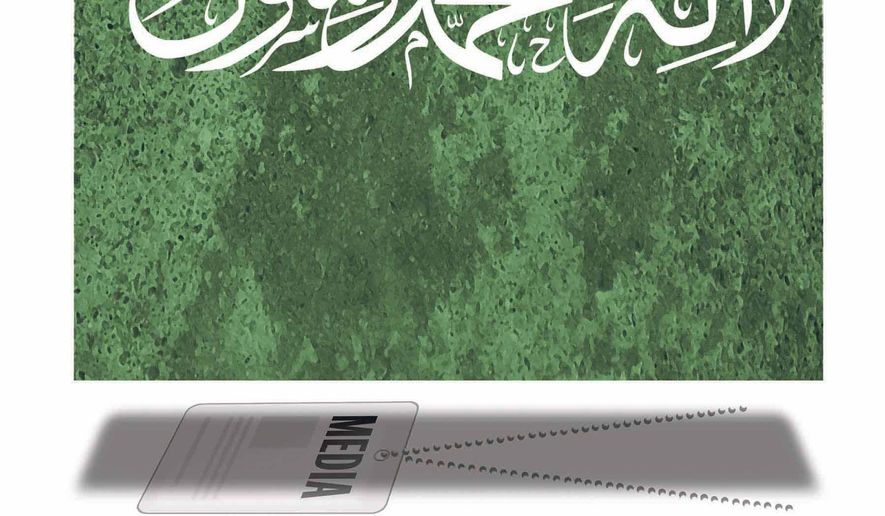OPINION:
Hamas, the Muslim Brotherhood branch that rules Gaza, sat out this month’s conflict between Israel and Palestinian Islamic Jihad, a smaller Gaza-based terrorist group tied to Iran’s rulers. However, perhaps to show it still rules the roost, Hamas issued sweeping restrictions on foreign journalists working in Gaza.
Among them: a prohibition against reporting on Gazans killed by misfired Palestinian rockets and a requirement that Israel be blamed for the battle.
In addition, Hamas ordered all foreign correspondents to employ Palestinian “sponsors” who must submit full reports on where those correspondents go, what they do and any “illogical questions” they ask.
The new rules warned that sponsors must “demonstrate national spirit, defend the Palestinian narrative and reject the foreigner’s bias to the Israeli narrative.”
The Foreign Press Association protested these “severe, unacceptable and unjustified restrictions on the freedom of the press.” Discussions ensued and, before long, the FPA was happily announcing that Hamas officials had come around.
Salama Marouf, director of the government media office in Gaza, agreed. “There are no restrictions,” he said. “We welcome all foreign journalists and media into Gaza, and we call on them to come.”
A happy ending, right? Not exactly. The Associated Press, one of the media organizations represented by the FPA, pointed out: “Even if the rules are officially withdrawn, Hamas has still signaled its expectations, which could have a chilling effect on critical coverage.”
That, too, fails to reflect a reality which is this: Reporters in Gaza have never been free and are not now.
Since Hamas wrested control of Gaza from rival Fatah in 2007, foreign journalists have been unable to work in the territory without Palestinian sponsors (more commonly known as “minders,” “stringers” or “fixers”) answerable to Hamas. They endanger both themselves and these hires if Hamas disapproves of their reporting.
Matti Friedman, a former reporter and editor in the Jerusalem bureau of The Associated Press has revealed all this and more in articles he wrote for Tablet, The Atlantic and more recently Sapir (a journal covering Jewish issues).
His pieces exposed Hamas’ intimidation and censorship, as well as the limits most journalists covering the Palestinian-Israel conflict impose on themselves based on ideology, bias and the desire for acceptance within social circles dominated by U.N. officials and employees of nongovernmental organizations who ignore Palestinian terrorism and rejectionism while regarding Israeli Jews as oppressors who don’t sincerely want peace.
Within this milieu, dissent is not tolerated. Just last weekend, the U.N. removed the head of one of its offices serving Palestinians after she posted a tweet condemning Islamic Jihad’s “indiscriminate rocket fire” — even though she subsequently apologized for “my poor judgment.”
The media are usually obedient. For example, Mr. Friedman wrote that during the conflict with Israel in the summer of 2014, the AP staff in Gaza City could see that Hamas was launching missiles from “right beside their office endangering reporters and other civilians nearby — and the AP wouldn’t report it.”
Nor did they inform readers that Hamas fighters had “burst into the AP’s Gaza bureau” and threatened the staff. And cameramen “waiting outside Shifa Hospital in Gaza City would film the arrival of civilian casualties and then, at a signal from an official, turn off their cameras when wounded and dead fighters came in, helping Hamas maintain the illusion that only civilians were dying.”
The most recent conflict featured such headlines as “Israel strikes what it calls terrorist targets” (ABC News) and “Israel cheers its wins, Gaza mourns its dead as cease-fire holds” (Washington Post).
Toeing the Hamas line does not guarantee safety: In 2006, Fox News reporter Steve Centanni and cameraman Olaf Wiig were kidnapped, blindfolded, handcuffed and held in an abandoned garage in the Gaza Strip by “a previously unknown group” calling itself the Holy Jihad Brigades. The two men were forced at gunpoint to denounce American policies and convert to Islam.
Released after 13 days, they were escorted to a Gaza hotel to meet with Hamas leader Ismail Haniyeh who, The New York Times reported, “had called for their captors to free them.”
The Times added that “there was speculation” that the kidnapping was an attempt “to embarrass” Mr. Haniyeh.
Such embarrassment was not apparent. And Mr. Haniyeh was doubtless pleased when, at a press conference, Mr. Wiig said he hoped his experience would not prevent other foreign journalists from covering Gaza. “That would be a great tragedy for the people of Palestine and especially for the people of Gaza,” he said.
The kidnappers, as far as we know, were never arrested. Nor has there been any further reporting on the “Holy Jihad Brigades.”
Last week’s AP dispatch on the new restrictions added what we might call the requisite moral equivalence clause: “In the long-running Israeli-Palestinian conflict, both sides have attempted to impose their narratives and limit negative coverage.” How so? Israeli authorities restrict media access to some military activities as well as to the country’s nuclear program.
So, the AP considers concealing who is killing whom on par with Israelis not revealing military secrets and not lifting the veil on their last-resort deterrence capabilities. Really?
While I see no cure for this situation, I can imagine treatment. It would entail reporters working under duress in Gaza — and elsewhere, e.g., Iran, Russia and China — acknowledging that to readers and viewers. And maybe media commentators at such high-visibility outlets as CNN and Fox might occasionally and honestly discuss this reality.
At the very least, they should stop propagating the falsehood that there is no significant difference between Hamas-ruled Gaza and Israel when it comes to “the freedom of the press” along with an extensive list of other human rights.
• Clifford D. May is the founder and president of the Foundation for Defense of Democracies and a columnist for The Washington Times.




Please read our comment policy before commenting.